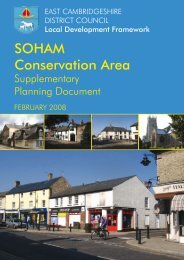East Cambridgeshire District Council Water Cycle Study Detailed ...
East Cambridgeshire District Council Water Cycle Study Detailed ...
East Cambridgeshire District Council Water Cycle Study Detailed ...
Create successful ePaper yourself
Turn your PDF publications into a flip-book with our unique Google optimized e-Paper software.
Stage 2 <strong>Water</strong> <strong>Cycle</strong> <strong>Study</strong>: Final Report<br />
Sept 2011<br />
45<br />
<strong>Cambridgeshire</strong> Horizons<br />
<strong>East</strong> <strong>Cambridgeshire</strong> – <strong>Detailed</strong> WCS<br />
The communities of Wicken Lode have relatively few floating-leaved species and an<br />
abundance of submerged, slender-leaved species. At present they are best placed somewhere<br />
in the Potamogeton pectinatus - Myriophyllum spicatum community (Fennel-leaved Pondweed,<br />
Spiked <strong>Water</strong> Milfoil) There are also scarce plants including flat‐stalked pondweed<br />
(Potamogeton friesii) and long‐stalked Pondweed (Potamogeton praelongus), both ‘RDB near<br />
threatened’ species and the rare species Nitella tenusissima which has been recorded in turf<br />
diggings and, in 1992, in Wicken Lode. Wicken Lode also contains a diverse invertebrate<br />
assemblage including the rare Depressed River Mussel Pseudanodonta complanata, also an<br />
SSSI interest feature.<br />
There is a general assumption (used for example in the Environment Agency Review of<br />
Consents) that pollution and/or excessive nutrients, particularly phosphorus, may cause<br />
damage or undesirable change to the other features. Therefore, phosphorus is the main focus<br />
for the assessment of water quality discharges. The target of 0.1mg/litre Soluble Reactive<br />
Phosphorus (annual average) is used as a provisional “threshold value” for river water in and<br />
adjacent to the site as per the EA RoC and JNCC Common Standards Monitoring guidance.<br />
Wicken Lode, where the spined loach is found, is the main source of water for Wicken Fen,<br />
both during normal flow conditions and during floods. The only other sources of water are<br />
rainfall, and drainage from agricultural land to the north of the Fen into Drainer’s Dyke (this<br />
dyke is isolated from other dykes on the fen because of water quality concerns but there are no<br />
consented discharges implicated here). Therefore, for the purposes of this assessment, if the<br />
water in Wicken Lode meets the 0.1mg/litre SRP as an annual average, no further assessment<br />
of water quality discharge consents will be required.<br />
There is no routine water quality sample point on Wicken Lode but there is one upstream on<br />
New River which feeds Wicken Lode. According to the Review of Consents work, SRP has<br />
never been above 0.033mg/litre during the whole of this survey period, which is well below the<br />
0.1mg/litre Favourable Condition Table required standard.<br />
Burwell WwTW discharges to the Catchwater Drain which itself drains to Burwell Lode. Wicken<br />
Lode flows into Burwell Lode at the south-west corner of Wicken Fen. It is theoretically<br />
possible for water to backflow from Burwell Lode into Wicken Lode, but the EA in their RoC<br />
considered this a sufficiently low eventuality that they did not consider backflow of water from<br />
Burwell Lode into Wicken Lode further (stating that ‘there is currently no connectivity between<br />
… Wicken Fen and the water in Burwell and Reach Lodes’) other than to state that if any<br />
proposal to abstract water from the southern end of Wicken Lode to back up the fen came<br />
forward a detailed investigation to determine whether Burwell Lode does backup Wicken Lode<br />
would be required.<br />
This is supported by Harding et al (2005) 32 which states that ‘Wicken Lode does not appear to<br />
be degraded by eutrophic water backing up from Reach Lode’ [Reach Lode merges with<br />
Burwell Lode before it reaches Wicken Lode].<br />
This being the case, there is no evidence on which to conclude that discharges to Burwell Lode<br />
associated with the increase in discharges from Burwell WwTW as described in this <strong>Detailed</strong><br />
WCS will have any impact on Wicken Lode or Wicken Fen with regard to any of its ecological<br />
features, based on extrapolation of historic trends/information.<br />
32<br />
Cook A. and Harding M. (2005) An evapotranspiration groundwater water balance for Wicken Fen. Ecology, Land<br />
and People (elp) on behalf of the National Trust<br />
Harding M., Smith K. And Williamson B. (2005) The ecohydrology of Wicken Fen and a <strong>Water</strong> Level Management<br />
Strategy. Ecology, Land and People (elp) on behalf of the National Trust






